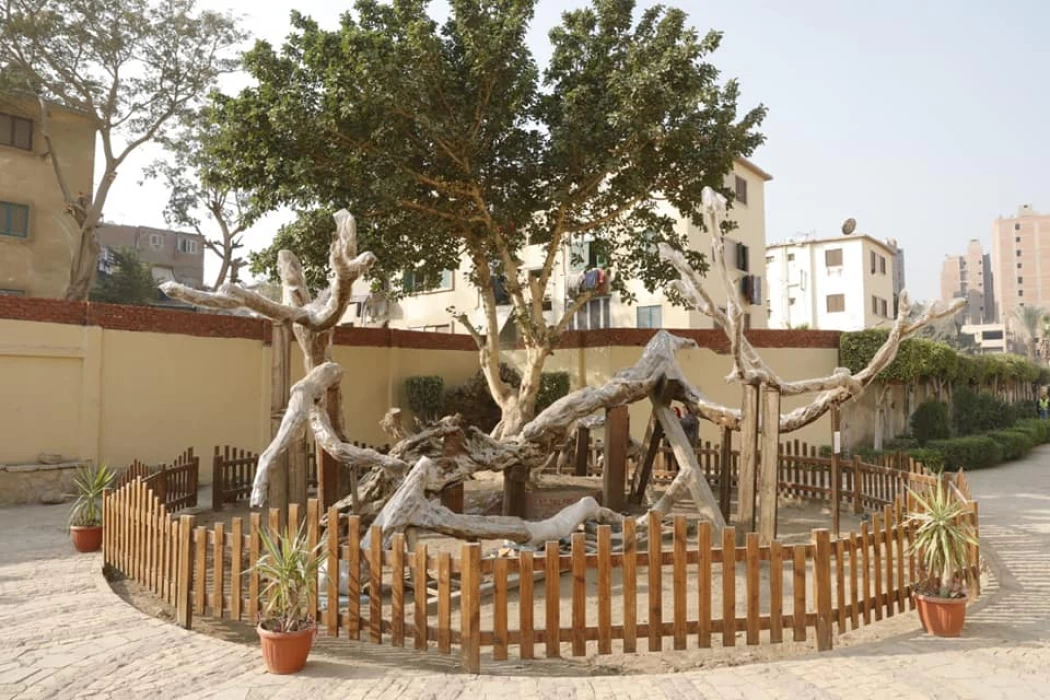
Mary's tree in Al-Matareya
The tale of Mary's tree
According to the website of the Ministry of Tourism and antiquities, the Mary tree in Matariya is one of the most important Coptic monuments.
The original tree of Mary became weak and weak and fell in 1656 ad, so a group of Franciscan fathers located in the neighboring church, which is now known as the Church of the tree of Mary, gathered branches and branches and planted it again and it has already grown again and its branches and branches branched.
Egypt was the first to host the Holy Family when it fled from the injustice of Herod, the king of the Jews (Roman) at that time, to he wanted to kill the child Christ, where he had learned a, there was a newborn who had been born and would be king over the Jews, so he was troubled and afraid for his kingdom, so he ordered the killing of all the children who were in the Bethlehem area of Palestine where Christ was born. The holy family fled to Egypt, and when Herod died, she returned to Palestine Again, and when Herod, the king of the Jews, sent those who were looking for them, and he was able to spy on their news because of the miracles that happened, the child came during his journey along the way, and among what he narrated and knew that the statues and idols were falling and he provided them with his recommendations to the rulers of Egypt, stressing the search for this family consisting of Joseph the Carpenter, the Virgin Mary and the Christ Child, and when the family felt the pursuit of Herod's men to them and their proximity to them, they hid under these The tree, bending over them with its branches, completely hid them from the eyes of Herod's Apostles until the knees passed and they survived their evil.
French soldiers and the tree of Mary
During the French campaign against Egypt, French soldiers stopped on their way to visit the Virgin Tree and many of them wrote their names on its branches with the teeth of their swords, and we can see this clearly on the antique tree.
According to the website of the Ministry of Tourism and antiquities, a group of French soldiers, who had limped to the tree in 1800, engraved their names on the branches of the Maryam tree with the teeth of their swords during the Battle of Ain Shams between Turkish soldiers and the commander of the French expedition Clipper, and their names are still engraved on the tree until now.
The current tree of Mary:
It is noteworthy that the original Virgin Mary tree at which the Holy Family rested was realized by weakness and weakness and fell in 1656 ad, so a group of priests took a branch of this tree and planted it in the church next to the tree area, called the Church of the tree of Mary, and the tree grew and branched, and recently a branch was taken from this tree, and it was planted adjacent to the original antique tree, which is full of leaves and Sycamore fruits now it is mentioned that people go to this tree to bless it, and there is a belief from some Christians that this tree makes women pregnant women who are unable to conceive.
An ancient archaeological tree that is about 3 thousand years old, adjacent to it is a water well from which Our Lady Mary drank and washed the clothes of Our Lady Isa, surrounded by a lot of drawings explaining the route of the Holy Family's journey in Egypt, while a fragrant smell smells in the place comes from elderberry plants that sprout spontaneously around the tree, here the Virgin Mary, Our Lady Isa and Yusuf al-Najjar stayed more than two thousand years ago.
The tree of Mary has attracted the attention of many historians of the Middle Ages, most notably Al-Maqrizi and Imam Assiut, as well as several travelers such as Eugenie, Empress of France, and Stanley Lane, the English Orientalist.
Universities for Egyptian priests
The area of the tree of Mary was once home to universities for Egyptian priests and scientists, who were famous around the world for teaching various types of Science and knowledge, and then this spot became famous for the tree of Mary after the Holy Family came to Egypt, and replaced it with that tree.
The journey of the Holy Family to Egypt
Egypt hosted the Holy Family "Mrs. Mary, Our Lady Isa and Joseph the carpenter", after they fled from Herod, the Roman king of the Jews, so as not to kill Christ, after he learned that there was a newborn who was born and would be a great king over the Jews, he feared for his kingdom and decided to kill all the children who were born in the Bethlehem area of Palestine and its borders, so the holy family fled from him and came to Egypt on a journey that took 4 years, starting from Sinai, passing through the Delta and the Nile Valley, and even Upper Egypt.
Herod sent his soldiers to Egypt to follow the Holy Family after rumors spread about the miracles of the little child, so the holy family hid under the tree, whose branches bent over them and hid them from the eyes of Herod's soldiers.
The Matariya garden has been famous for centuries as one of the holy places, and the Coptic Church still celebrates the anniversary of the Holy Family's trip to Egypt in early June every year.
The tree of Mary and its benefits
The current tree of Mary is fruitful with sycamores, and the Copts bless her, as they believe that she heals the infertile lady and makes her pregnant.














